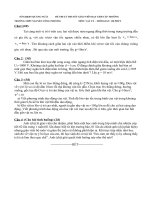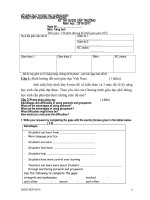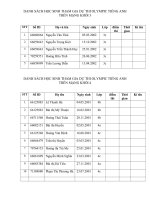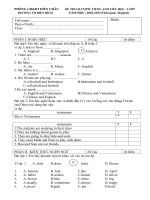Đề thi GVDG Tiếng Anh cấp trường 2010-2011
Bạn đang xem bản rút gọn của tài liệu. Xem và tải ngay bản đầy đủ của tài liệu tại đây (145.68 KB, 5 trang )
Sở GIáO DụC Và ĐàO TạO QUảNG NGãI
Tr ờng thpt NGUYễN CÔNG PHƯƠNG
Kỳ THI GVDG CấP TRƯờNG
Năm học : 2010-2011
Ngày thi : ..
Môn: Tiếng Anh
Thời gian : 120 phút (không kể thời gian giao đề)
Họ & tên giáo viên dự thi : Giám thị 1 :
.
Giám thị 2 :
.
M phách : ã
...
Giám khảo 1 : Giám khảo 2: Điểm : M phách:ã
_ Đề thi này gồm có 07 (bảy) trang, không kể tờ phách . Làm bài ngay trên đề thi.
Cõu 1: nh hng i mi giỏo dc Vit Nam (1 im)
Anh (ch) hóy trỡnh by 6 mc v kin thc v 3 mc v k nng
hc sinh cn phi t c. Theo yờu cu ca Chng trỡnh giỏo dc ph thụng,
hc sinh cn phi t c nhng mc no?
Câu 2:Phơng pháp giảng dạy ( 4 điểm)
Advantages and difficulties of using pairwork and groupwork:
What are the advantages of using pairwork?
What are the advantages of using groupwork?
What difficulties might there be?
How would you overcome the difficulties?
1. Write your answers by completing the gaps with the words/ phrases given in the tables below.
( 2 đ)
Advantages
- Students can learn from ..................................................... .
- More language practice .
- Students are more .............................................................. .
- Students feel more ............................................................. .
- Students help ....................................................................... .
- Students have more control over learning .
GVDG-NCP-2010
1
- Teachers can learn more about students’ ..............................................................
through monitoring pairwork and groupwork.
Use the following to complete the gaps:
strengths and weaknesses - involved -
each other - secure - each other
1. Complete the solutions with your own ideas. (2 ®)
Possible difficulties Solutions
- Noise.
- Students make
mistakes.
- Difficult to control the
class.
- Boys and girls don’t
want to work together.
- Weak groups can’t help
each other.
- Can’t move the tables
- Students don’t work and
expect the teacher to
teach
Don’t let noise levels become too high – remind ss that there
are other classes. However, remember that it is good ‘noise’
and other teachers and principals should acknowledge that
this "noise" ..............................................................................
Give enough preparation (whole class, pairwork). Studies
show that ss correct each other when ss make mistakes.
Teacher ...................................................................................
Give clearly defined tasks (not too long), and give
clear ....................................................... . Monitor effectively.
Organise your groups carefully. Encourage boys and
girls ...........................................................................................
...... . Explain that in real life we have to talk to each other!
Organise mixed-ability groups so stronger students can help
weaker ones. Monitor carefully and encourage ss as you
monitor.
Move one row to sit ........................................................... .
Introduce pairwork and groupwork gradually.
Monitor carefully. e.g. For pairwork, use open and closed pairs
during the presentation of dialogues and the drill. Gradually
extend the pairwork and monitor. Make ss aware of the
advantages of pairwork.
For groupwork, the T.’s classroom management must be very
clear: seating needs to be considered carefully. If the teacher
is using groupwork for the first time, they should demo with a
group of ss in front of the class. Ss have to get used to:
- starting and stopping when the T. tells them (maybe
by using a special signal)
- working quietly
- listening carefully to instructions
- asking Ts. for clarification
- asking each other questions, not only the T.
GVDG-NCP-2010
2
Câu 3: Kiến thức chuyên môn: (4 điểm)
Cho đáp án (không có hớng dẫn chấm và biểu điểm) cho các phần kiểm tra Ngữ âm, Ngữ
pháp và Đọc hiểu trong một đề thi Học sinh giỏi THPT sau đây:
EXERCISE 1 ( 1 )
Choose the word with the main stress placed differently from that of the others in each group.
1. A. cartoon B. fiction C. fasten D. horror
2. A. voyage B. suppose C. tragic D. iceberg
3. A. championship B. passionate C. tournament D. equipment
4. A. internation B. information C. eliminate D. competition
5. A. trophy B. compete C. announce D. retire
6. A. promote B. defeat C. hero D. postpone
7. A. involve B. honor C. final D. nation
8. A. historic B. cathedral C. unusual D. national
9. A. district B. control C. global D. cover
10. A. forester B. policy C. erosion D. vegetable
ANSWERS:
1. 2. 3. 4. 5. 6. 7. 8. 9. 10.
EXERCISE 2 ( 1 )
Choose the correct answer to fill in the gap in each of the following sentences.
11. By the time they arrived at the theatre, the movie _____________.
A. is ending B. would end C. has ended D. had ended
12. The two friends _________in the same company for a year before they ________each other.
A. has been working/ recognized B. had been working/ recognized
C. were working/ had recognized D. have been working/ had recognized
13. I got a bad sunburn because I ________in the sun for days.
A. had lain B. had laid C. have lain D. have laid
14. They were asked not to disturb the old man because he ____________.
A. is sleeping B. is asleep C. was sleeping D. was slept
15. Over the past few years the cost of living __________considerably.
A. is rising B. was rising C. was risen D. has risen
16. By the end of next year, Mr. Park _____________for this company for 35 years.
A. will work B. will have worked C. will be working D. has worked
17. What __________to you yesterday?
A. happened B. had happened C. was happened D. was happening
18. He broke his arm when he ___________football.
A. was playing B. played C. had played D. plays
19. What will you do when you ___________from high school ?
A. graduate B. will graduate C. have graduated D. graduated
20. After I _______ from college, I________ as a teacher.
A. had graduated / work B. had graduated / worked C. graduated / worked D. graduate /
work
ANSWERS:
11 12 13 14 15 16 17 18 19 20
EXERCISE 3 ( 2 )
Read the passage and choose the correct word for each of the blanks from 1-10.
GVDG-NCP-2010
3
Body language includes the gestures and movements people make when they (1)______. People too
often do not (2)____ to their body language. A person may think that he is communicating a clear
message when he speaks but if his body is sending a different message, his audience is just not going
to (3)______ as he expected. You may think you are a competent speaker but if your audiences see you
slouching, not making eye contact, or pulling your earlobes, they will not feel confident that they can
(4)______ what you are saying. They may even stop listening. When we talk, 90% of the vast majority of
the information people receive (5)______ us is in our gestures, expressions, tone of voice and all other
things and only 10% comes from the words we use when we speak.
We start to read each others (6)_____ from a very young age. Anytime we speak, the other person is
checking our gestures and movements to see (7)_______ they match what we are saying. You may not
be (8)_______ of doing this, but we all do it. It comes naturally and is something we learn to do very well
over time. If you think about your friends or your co-workers for example, after a while you get to know
their moods just by (9)________ their body language or gestures.
An effective communicator will use what he or she sees in other people and (10)_______ of it. You
need to know and understand your own body language. If you can exert a certain degree of control over
the messages given by your body, you will be able to manipulate the responses of other people.
1. A. relate B. communicate C. behave D. snow
2. A. take effect B. pay respect C. pay attention D. make a prediction
3. A. react B. argue C. agree D. nod
4. A. believable B. doubtful C. certain D. trust
5. A. to B. from C. for D. with
6. A. body language B. languages C. letters D. numbers
7. A. but B. so C. if D. while
8. A. considerable B. aware C. pleasure D. favour
9. A. learning B. imitating C. observing D. making
10. A. make out B. take advantage C. pay a compliment D. get over
ANSWERS:
1 2 3 4 5 6 7 8 9 10
Câu 4: ứng xử tình huống s phạm : (1 iểm)
Đọc bài báo sau đây về tình huống đợc một giáo viên kể lại. Anh (chị) sẽ xử lý nh thế nào nếu ở
vào hoàn cảnh tơng tự cô giáo Thùy?
Trc mt hc trũ, giỏo viờn thng phi ng x ỳng mc, khuụn phộp, khụng thỏi
quỏ. Vỡ th, s kim ch cm xỳc, c bit l nhng cn núng gin l vụ cựng cn thit.
Hi hc cp 2, tụi cú mt cu bn rt nghch ngm, hay tỡm cỏch chc phỏ trong cỏc gi
hc.
Tờn cu l Minh, trựng tờn vi thy giỏo dy mụn toỏn. Mt ln, thy ang ging bi,
cu ta ngi khụng yờn, c quay lờn, quay xung núi chuyn, lm n.
Thy giỏo bc lm, i thng xung, xỏch tai cu ta ng lờn, hi: "Ti sao em lm n
trong gi hc?. Khụng ng, cu ỏp ngay: Tha thy, ti bn Tnh chi em l tiờn s thng
Minh".
Mt bng, ngay lp tc, thy cho mt cỏi tỏt nh tri giỏng, hn 5 ngún tay lờn mỏ,
ui cu ra khi lp. C lp chỳng tụi s xanh mt, cũn cu kia i ra khi lp nhng vn ngm
ngm thỏch thc sau lng thy.
Gn 20 nm sau, tụi gp li cõu chuyn ny chớnh lp hc sinh mỡnh ch nhim.
GVDG-NCP-2010
4
Trong giờ môn Vật lý, khi cô giáo đang giảng bài, em Hồng Loan vẫn ngỗi dưới lớp
nghịch ngợm, mất tập trung.
Thùy, cô giáo Vật lý đã nhiều lần nhắc nhở nhẹ nhàng, nhưng Loan vẫn ‘phớt” lời, thậm
chí, còn cười đùa rất vô duyên.
Không kiềm chế được nữa, cô đập bàn quát : “Em Loan! Không học thì ra ngoài ngay,
đừng có cái kiểu láo tôm láo cá như thế trong lớp học.”
Trong tiếng ồn ào của lớp học, tiếng Hồng Loan vang lên rõ mồn một: “Tiên sư đứa nào
chửi tao”.
Cô Thùy lặng người! 30 tuổi đời, 7 năm tuổi nghề, cô chưa bao giờ ở trong tình thế này.
Cố gắng kìm lại cơn giận, cô nói nhẹ nhàng nhưng kiên quyết: “Em nào vừa nói, đứng
dậy!”. Lớp lặng im, không em học sinh nào lên tiếng, ngay cả thủ phạm.
Cô vẫn tiếp tục nhẹ nhàng: “Tôi hỏi em nào vừa nói, tôi cho một cơ hội đứng dậy tự
nhận lỗi”. Vẫn không ai lên tiếng, không khí lớp học căng thẳng vô cùng. Cô buồn bã lắc đầu:
“Xin lỗi các em, tôi không thể tiếp tục dạy tiết học này. Phần còn lại của giờ học, tôi yêu cầu
lớp tự sinh hoạt”. Rồi cô lặng lẽ xách cặp đi ra.
Không biết, các em đã tự sinh hoạt, thảo luận những gì. Nhưng đến cuối giờ học, em lớp
trưởng xuống phòng chờ giáo viên mời cô lên lớp.
Trong lớp học, Hồng Loan với đôi mắt đỏ hoe, nức nở khóc và xin lỗi cô giáo. Cô vẫn
nói với Loan bằng những lời nhẹ nhàng, không hề trách mắng.
Sau sự việc ấy, Loan gửi cho tôi - là giáo viên chủ nhiệm - bản tường trình và bản kiểm
điểm.
Trong đó, em viết: "Đây thực sự là lỗi lầm lớn trong cuộc đời em. Em rất biết ơn cô
Thùy vì cô đã cho em một bài học sâu sắc về lòng bao dung”.
Tôi cầm bản kiểm điểm của Loan, lại nhớ tới hình ảnh bàn tay hằn trên má của cậu bạn
năm xưa và tự hỏi, không biết mình sẽ ứng xử như thế nào nếu ở vào tình huống của cô Thùy?
Liệu mình có đủ bình tĩnh để không cho học sinh một cái tát, hay ít ra là không đuổi học sinh ra
khỏi lớp học?
Trang Nhung (Trường THPT Lê Viết Tạo, huyện Hoằng Hóa, tỉnh Thanh Hóa)
GVDG-NCP-2010
5









